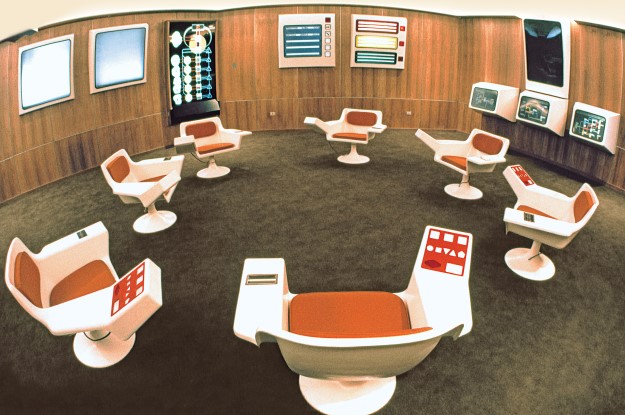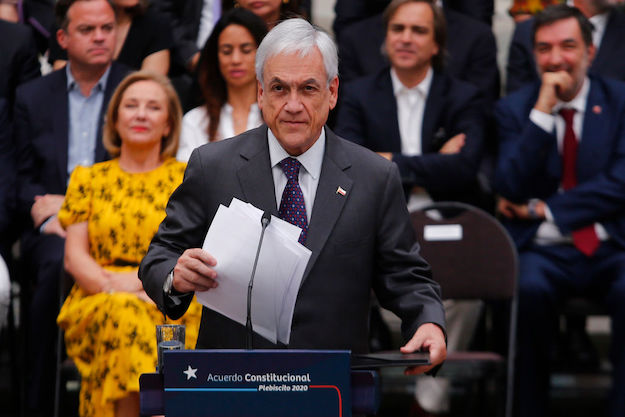This article is adapted from AQ’s latest issue on Latin America’s anti-corruption movement. | Leer en español
SANTIAGO — “We all knew the coup was coming, we just didn’t know when,” said Raúl Espejo, who in 1973 was an enthusiastic young engineer at CORFO, Chile’s national development agency.
The CORFO team pressed ahead anyway with one of President Salvador Allende’s most ambitious and daring projects: An electronic “nervous system” to Chile’s economy that would make condensed, actionable information available to the country’s decision-makers in real time.
The “Cybersyn”project, which was key to Allende’s ambitions of exerting greater state control over the economy and relied on a network of Telex machines, has been compared by some in years since to a primitive, early internet.
The centerpiece was a hexagonal, wood-paneled operations room that the team hoped to build in every government ministry. Here, officials would process data sent by workers up and down Chile. Drawing on the work of psychologist George A. Miller’s belief that seven is the “magic number” for a productive conversation, the room’s designers set seven ergonomically designed chairs in a circle. There were to be no keyboards, as typing skills were perceived as the domain of secretaries, not senior officials. Rather, a set of buttons on each chair’s right-hand armrest controlled five screens, allowing officials to track variables like worker attendance and productivity.
The room impressed delegations from the U.S., U.K. and Japan, who were greeted by an eerily futuristic film of Allende. “This is not science fiction, but real science,” Allende told them.
Like many things associated with Allende’s government, the project was controversial and surrounded by mystique. Things got worse when a journalist interviewed Espejo and then described the project as a sinister and secretive plot to assert Marxist control over the economy.
Angered, Espejo sat down on September 10, 1973, to write a response to the journalist. Setting his letter aside to mail the following morning, he left to attend the farewell of a colleague who was due to leave Chile the next day.
Espejo never got to send his letter, as tanks rolled into Santiago at twilight. The coup happened the next day.
The British Connection
Chile had elected Allende in 1970 to the alarm of Richard Nixon’s Cold War-gripped White House. His task was arduous from the outset: He had won just over 36% of the total vote — a margin of just 1.3% over his closest competitor.
If simply governing with a weak mandate and congressional minority seemed difficult, then molding Chile’s economic framework to his socialist ideals was an even more gargantuan task.
But in July 1971, Fernando Flores, a prodigious 28-year-old engineer who had assumed the technical direction of CORFO the year before, had an idea. Flores was heavily influenced by the writings of Stafford Beer, an English pioneer of cybernetics, which he described as the study of the flow of information around a system. Believing Allende’s nationalization plans would require uncommon ingenuity, Flores sent a hopeful letter to Beer. At best, Beer might be able to contract the help of one of his associates, Flores thought.
But Flores’ ambition captivated Beer, who was growing frustrated at the lack of traction his ideas got back home. After negotiating a daily fee of $500 — and a constant supply of chocolate, wine and cigars — for his services, Beer arrived in Santiago in November 1972, having exchanged letters with Allende himself.
According to historian Eden Medina, who interviewed Cybersyn’s protagonists for her book Cybernetic Revolutionaries, Allende was taken by Beer’s ideas. His only stipulation was that the project must increase worker participation.
So Beer and Flores pursued a system inspired by Beer’s work on the Viable System Model — a theoretical framework in the nascent field of information technology that equated the machine to the human body.
The team set to work at a furious pace. In an old warehouse they found 500 Telex machines — a precursor to the fax machine — which a previous government had purchased but never used. In just four months, the team had distributed the machines to factories across the country, connecting them to the “nerve center” in the capital.
An unassuming eighth-floor room in CORFO’s headquarters in Santiago became Cybersyn’s focal point, to which factories sent data and requests back to the government. Espejo recalls regularly working long into the night, processing the data that had begun to stream in from factories.
Technical constraints often hampered progress, and Beer would even bring spare parts into the country to circumvent an “invisible blockade” placed on Chile by the U.S. that made importing goods difficult.
Innovation Interrupted
While the prototype operations room was never moved to its envisioned home in La Moneda, Chile’s presidential palace, Cybersyn’s operational elements did show some worth in October 1972 when a CIA-supported truckers’ strike threatened to grind the economy to a standstill.
Even as 50,000 trucks blockaded Santiago’s streets, the government was able to ascertain which unions remained loyal and guide a fleet of 200 trucks into the city via the roads that remained open, communicating almost instantaneously via the Telex network.
Impressive as this was, the Cybersyn team had grander ambitions still. Back in the U.K., Stafford Beer’s son, Simon, used old radio parts to develop a small device with two dials that, in theory, could be placed in Chilean households for citizens to give feedback on policy proposals they saw on television.
The Cybersyn team began using the system in project meetings.
“You had (the handset) on your lap and could give feedback to the person giving a presentation,” Espejo said. “An algorithm was integrating all of the feedback, which would appear on a screen in front of the speaker.”
Although the project was tested in two cities, it would never fully come to fruition.
Allende is believed to have shot himself during the assault on La Moneda, and soon military agents came to question the Cybersyn team. Espejo forged a successful career as a consultant in the U.K. and never went back to the site of the operations room, which soldiers destroyed in the days following the coup, according to some accounts. Flores was held in a prison camp in southern Chile until 1976. He moved to Silicon Valley, eventually returning to Chile and becoming a senator.
Beer was in the U.K. when news of the coup reached him. He never returned to Chile and renounced many of his material possessions soon after, trading an affluent life in Surrey for an isolated cottage in the Welsh hills. The Chilean philosopher Humberto Maturana famously remarked that Beer had arrived in the country a businessman and left a hippie.
Almost as quickly as it had begun, the Cybersyn dream dissolved into little more than an ephemeral footnote in the controversial story of Allende’s Marxist experiment.
—
Bartlett is a freelance journalist based in Chile






